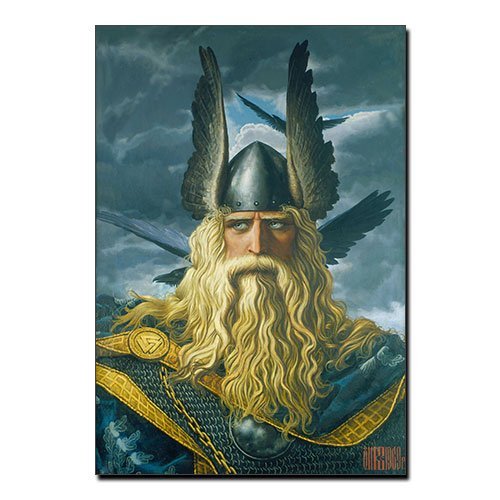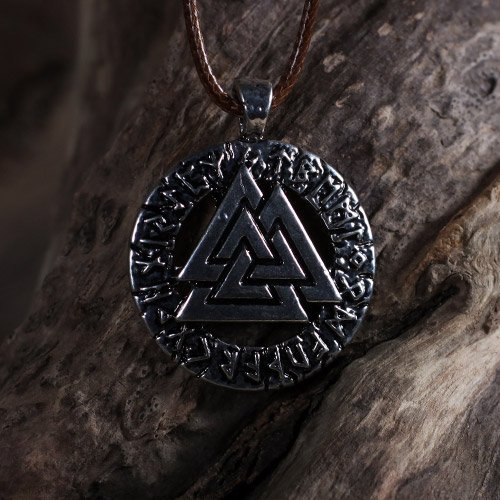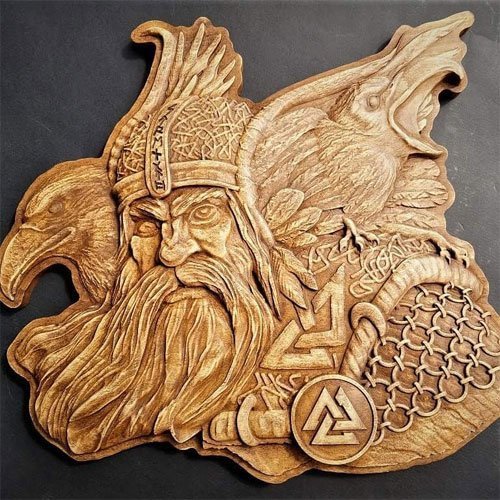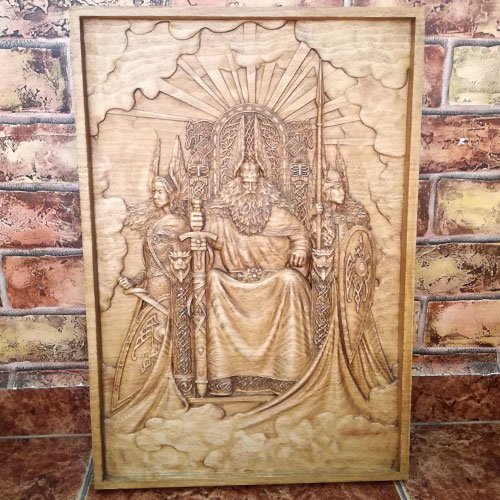Do you want to order gold jewelry? Prices shown are approximative!
Contact us to receive an actual price before placing an order.
Do you want to order gold jewelry? Prices shown are approximative!
Contact us to receive an actual price before placing an order.
 Who is Odin?
Who is Odin?
Odin is one of the most famous figures in the Norse myths. He is the leader of Æsir (Assa, Azza, Osir) and ruler of Valhalla. Odin is the Norse equivalent of Dyēus Phter - creator and chief god of the Aryan race. He was worshiped under different names in the different regions of Europe. In Germanic / Norse mythology he was named Odin and Wodan.
Odin is a son of Bestla and Bor. With Frigga, he is the father of Baldur, Hod, and Hermod. Thor (Donar) is his son from the goddess Jord. Wodan and the giantess Grid are the parents of Vidar.
Odin is a god of war and death. He is also the god of poetry and wisdom. He hung for 9 days, pierced by his own spear, on Yggdrasil. Here he learned nine powerful songs of the wise, and 18 runes. Odin can ask the spirits of the slain. His hall in Asgard is Valaskjalf ("shelf of the killed in battle"). His throne Hlidskjalf is located there. Upon his shoulders are two ravens, Munin ("Memory") and Hugin ("Thought"). They help Wodan to observe what happens in the nine worlds.
In Ragnarok, Odin will ride his eight-legged horse Sleipnir. Odin will make straight for Fenrir but after a long battle, he will be devoured by the giant wolf. Vidar will avenge the death of his father as he will tear Fenrir's throat asunder. The origins of the names of the supreme god are arguable. Some scientists think that Wodan is derived from the Old German wōđaz - prophet or from óðr (Old Norse), mad, frantic, furious.
If you are interested in Norse Wall Art Decoration like Canvas, Framed art prints and Wood carvings you can visit our online store Forefathers-Art.com:
View our collection of Norse Wood Carvings
View our collection of Norse Canvas Prints
View our collection of Norse Framed Posters
Another theory is that Wotan comes from the Indo-European root "wâ" (to blow) and there designates The Wind God. Some researchers believe that the names Odin (Wotan) are with ancient Cimmerian origin - from Odin "oдин" (Old Bulgarian) meaning "The only One" or "The First One". Wotan from "водя" (vodja) means "to lead" or "видя" (vidja) means "to see", like "Veda" which means "to see", "to know" in Sanskrit.
Odin has 170 recorded names
Some of them are Aldaföðr (father of men), Alföðr (Allfather), Ásagrimmr (lord of the Aesir), Baldrsfaðr (father of Baldr), Jörmunr (The Mighty One, Cosmic) and so on.

The symbol mostly associated with Odin is the valknut. The symbol consists of three interlocked triangles. Valknut is somehow similar to Triskele. The valknut originate from Old Norse and literally means "knot of the slain warriors". The symbol was used by many Germanic tribes Goths, Saxons, Angles, Vikings. Valknut is associated with rituals surrounding death in battle or human sacrifices.
Don't miss to explore our collection of Sterling Silver and Gold Norse Jewelry:
View our Viking Pendants and Necklaces HERE
Theories about Odin's origin
 Thor Heyerdahl believed that Odin was a real ruler lived in the area of present-day Ukraine, the Caucasus mountains or Crimea while some, including Noah Webster, have suggested that Wodan was a fair-haired chieftain ancestral to the Germanic peoples, and a King of Thrace. The Norse gods are described descended from the Trojans. He based his study on The Prose Edda: "Their son was Trór, Thor, who was fostered in Thrace. Finally, the son of Fríallaf was Vóden, whom we call Odin, who came to Germany (Saxland) and established the royal lines there."
Thor Heyerdahl believed that Odin was a real ruler lived in the area of present-day Ukraine, the Caucasus mountains or Crimea while some, including Noah Webster, have suggested that Wodan was a fair-haired chieftain ancestral to the Germanic peoples, and a King of Thrace. The Norse gods are described descended from the Trojans. He based his study on The Prose Edda: "Their son was Trór, Thor, who was fostered in Thrace. Finally, the son of Fríallaf was Vóden, whom we call Odin, who came to Germany (Saxland) and established the royal lines there."
Similar gods in the Indo-European pantheon
 Similar to the figure of Odin are probable the Kimmerian supreme god Krom and the Celtic deity Crom Cruach.
Similar to the figure of Odin are probable the Kimmerian supreme god Krom and the Celtic deity Crom Cruach.
Little is known about Cimmerian mythology, but certainly, it can be concluded that Krom is the supreme leader of the White gods (Azza), the ruler of Balhalla, father of the sun god Horst/Hrst/Hors. Its name is derived from the ancient Cimmerian word for "thunder" ("гръм" - grum) or from the root "громя" (gromja - "to rout the enemy"). It is called also "The White Dragon" and "Allfather".
Crom Cruach (Crúaich) was a god of pagan Ireland. According to the Irish annals, Crom was the god of the arrivals from The Balkans called Fomorians or the people of Fir Bolg. He is the god of war and fertility. His name could be interpreted in several ways: "bent, crooked, stooped, bowed, curved, crescent" or "(corn) stack".